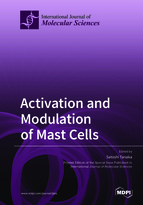Activation and Modulation of Mast Cells
A special issue of International Journal of Molecular Sciences (ISSN 1422-0067). This special issue belongs to the section "Molecular Immunology".
Deadline for manuscript submissions: closed (31 December 2019) | Viewed by 53519
Special Issue Editor
Special Issue Information
Dear Colleagues,
Accumulating evidence suggests that mast cells should be involved in a wide variety of inflammatory responses in addition to IgE-mediated immediate allergic responses. Mast cells were found to modulate cutaneous, bronchial, and intestinal inflammation in cooperation with dendritic cells, Th2 cells, Treg cells, and type 2 innate lymphoid cells. Mast cells could be novel therapeutic targets of various chronic inflammatory diseases, such as atopic dermatitis, asthma, and inflammatory bowel diseases, although it remains to be fully clarified how tissue mast cells are activated. Because all these inflammatory responses do not occur in the context of IgE, an understanding of the IgE-independent activation of mast cells should shed light on novel modulatory roles of tissue mast cells.
We warmly welcome original manuscripts and reviews dealing with the mechanism of the IgE-independent activation of mast cells, the characterization of tissue resident mast cells, and the modulation of mast cell activation.
Prof. Dr. Satoshi Tanaka
Guest Editor
Manuscript Submission Information
Manuscripts should be submitted online at www.mdpi.com by registering and logging in to this website. Once you are registered, click here to go to the submission form. Manuscripts can be submitted until the deadline. All submissions that pass pre-check are peer-reviewed. Accepted papers will be published continuously in the journal (as soon as accepted) and will be listed together on the special issue website. Research articles, review articles as well as short communications are invited. For planned papers, a title and short abstract (about 100 words) can be sent to the Editorial Office for announcement on this website.
Submitted manuscripts should not have been published previously, nor be under consideration for publication elsewhere (except conference proceedings papers). All manuscripts are thoroughly refereed through a single-blind peer-review process. A guide for authors and other relevant information for submission of manuscripts is available on the Instructions for Authors page. International Journal of Molecular Sciences is an international peer-reviewed open access semimonthly journal published by MDPI.
Please visit the Instructions for Authors page before submitting a manuscript. There is an Article Processing Charge (APC) for publication in this open access journal. For details about the APC please see here. Submitted papers should be well formatted and use good English. Authors may use MDPI's English editing service prior to publication or during author revisions.
Keywords
- mast cell
- inflammation
- G protein-coupled receptor (GPCR)
- Mas-related G protein-coupled receptor (Mrgpr)
- degranulation
- immune tolerance
- mast cell secretagogue
- histamine
- skin
- gastrointestinal tract







